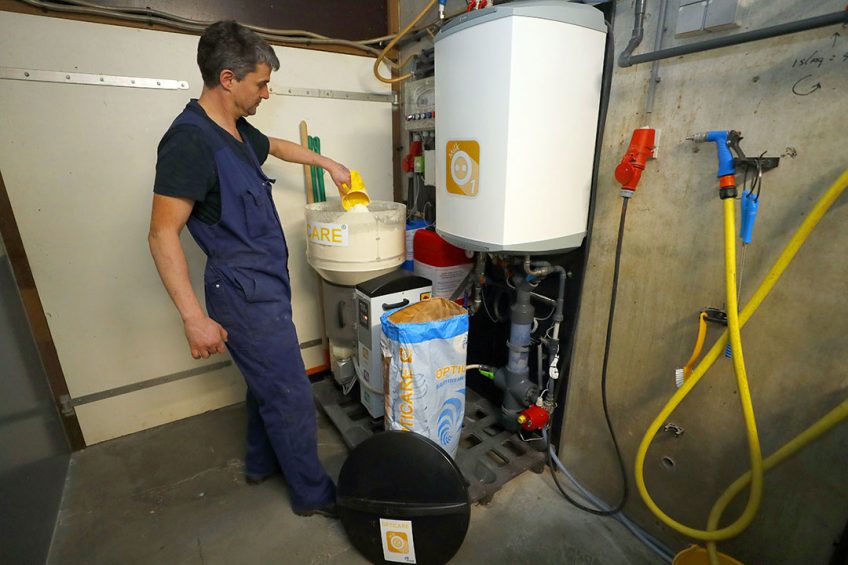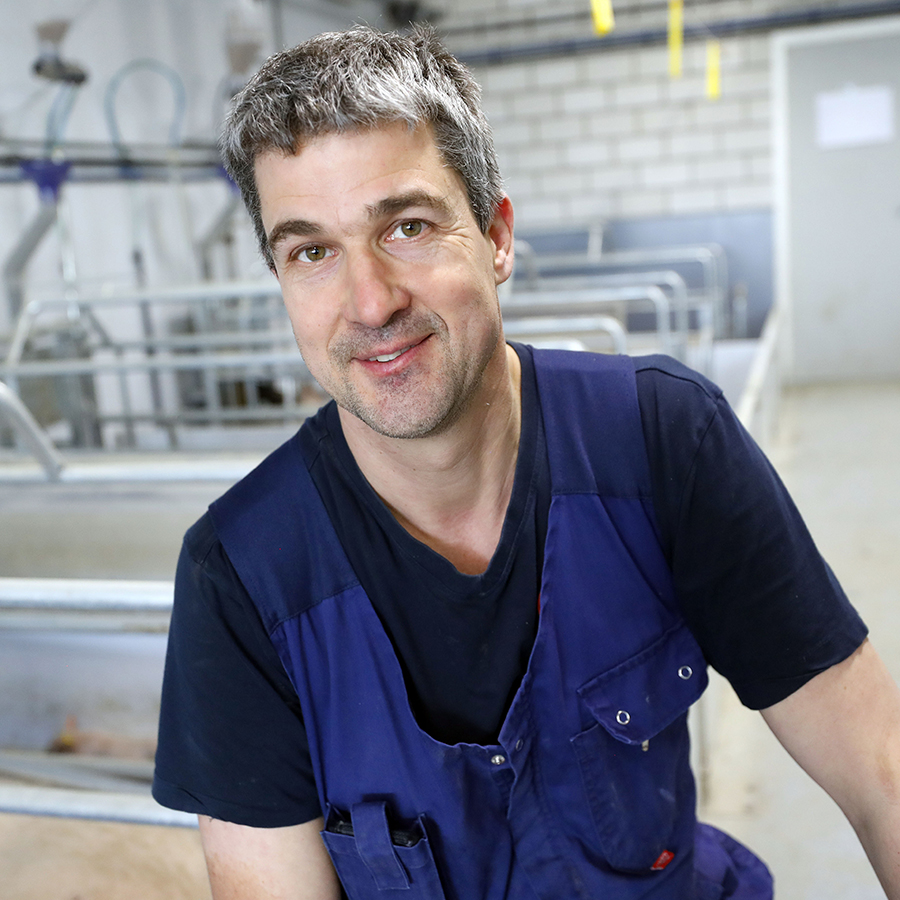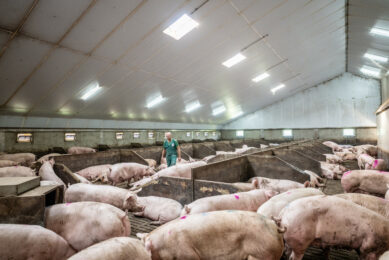Training piglets to grow from the start

Pigs have a lot of potential for growth. In order to live up to that, it’s important to train the animals’ guts virtually straight from birth. Keeping that in mind, an early feeding programme with an automatic dispensing system was installed at Bankers farm, the Netherlands.
Perhaps not the most delicious of anecdotes to start with, but it is a suitable way to start this article. A sow, lying in her lactation crate, rises up as nature calls. Several onlookers, Roel van der Bruggen being one of them, see solid droppings slowly disintegrating and hit the floor. The phenomenon must have inspired Mr van der Bruggen because suddenly he hops into a neighbouring pen and starts browsing on the floor. Not much later, he gets up, holding in his hand very small bits of manure, different in composition, almost cat like. Proudly he says: “You see, this is what healthy young piglets can produce before weaning. These are of good composition and have a nice black colour. That is an indication that their gut health is very good.”
New farm, new innovations
This little anecdote took place inside a brand new addition of Bankers farm, located near Deurne, in the south of the Netherlands. Owner Wilfried Bankers, aged 46, in 2018 added a new large sow house to his swine farm, offering space to an additional 500 sows to his facility. Mr Bankers didn’t economise on innovations – rather he choose for some luxury in the construction, which cost € 1.3 million altogether. He says, “I’ve got another 15 years to work and what counts for me is that me and my staff can work in here as pleasantly as possible.” The new pig house is therefore equipped with e.g. dust-reducing lighting (Freshlight Agri), farrowing feeding equipment (Nedap) and balance floors (Nooyen).
|
Only the genetics part comes from abroad: with its high prolificacy rates, Mr Bankers opted for DanBred sows. Performance figures have soared, and for the third year in a row he has achieved more than 35 piglets per sow per year, he says.
Good management is one of the secrets, he admits, to make it work with Danish sows. The animals are said to have a reputation of being difficult to manage, but not so on Bankers farm. On the contrary, upon entering each pig room, time after time the sows and their offspring are calm and often sleeping.
Training piglets
One novelty – related to the manure composition described in the introductory paragraph – cannot be found to its full extent yet at many other farms. The pig nutrition programme Opticare is all about training young piglets to prepare to eat solid feed at an early age. The programme, designed by Dutch nutritionist advisory company Swinco (short for ‘swine nutrition company’), has recently grown out to consist of much more than just about animal nutrition.
Essentially, the system combines and improves existing technologies into a programme that should make life easier for producers and pigs alike. Take for example the way piglets will first meet the feeding programme: in yellow cups with a nipple.

Similar concepts have hit the market before, but the devil is in the detail, as Roel van den Bruggen, account manager swine at Swinco, explains: “We have tried to take out the pitfalls of the cup system.” For instance, tubes can be screwed into the solid cups, which means that replacement can be done easily and swiftly. In addition, the nipple system will make sure the milk will never overflow, so no milk is wasted.
Automatic dispensing system
Through an automatic dispensing system, the cups are connected to a central kitchen, where the artificial milk is mixed automatically, using milk powder and water. The mixture is brewed at 55ºC, cooled down to 30ºC, and then sent into the circuit through the ten lactation rooms. Everything that is not consumed will come back to the kitchen, can be warmed up again through a heat exchanger, and can be re-distributed.

Central element in the kitchen is the dispenser, as this model mixes 1 litre at a time – again fully automatically, only the circuit demands a refill. That way there will always be fresh amounts of milk, in consistent amounts, ready for consumption at any given moment of the day. The only thing farmers or caretakers have to do is fill up the milk powder reservoir from time to time. The system will take care of the rest. With 3 buttons, for starting, filling and cleaning, the entire concept can be managed – all in all easy to learn.

Context and benefits of cups
The development of the novel cup system with automatic dispensers should be seen in the context of a reduction of the management toolkit European farmers have to get their piglets through weaning. For a long time, antibiotic growth promoters (AGPs), zinc or copper were added to young animal nutrition to avoid negative side-effects during weaning. In the EU, AGPs have been forbidden for a decade, the same will happen with the therapeutic usage of zinc oxide throughout the EU by 2022 and also levels of copper are being brought down.

Mr Van der Bruggen says, “Essentially, the training is about making the gut get used to protein from plant origin, i.e. pig feed. Originally, a piglet will receive protein from animal origin, i.e. milk.”
To that end, the company introduced a three-step phase feed (available in liquid and solid form) during lactation several years ago, with ingredients gradually changing as the pigs grow older. With the training, starting from day 2, the pigs’ guts get better prepared for what is to come later in life, he says – and that allows the pig to fully express its genetic potential. According to Mr Van der Bruggen, this philosophy pays off at various moments in a pig’s life. He says, “At weaning, the piglets will be 400g heavier; and at 26-27kg the difference is 1.2kg heavier.”

Additional benefits, according to Mr Van der Bruggen, include that pigs grow more uniform and that the system will help increase the number of pigs weaned. All in all, pig farmers reap the benefit with sending more pigs more uniformly to slaughterhouse at an earlier age or heavier weight. In a hypothetical calculation involving a farm with roughly 30,000 piglets produced/year, profit using the Opticare approach could be around € 30,000, with details varying from farm to farm.
In practice at Bankers farm
In practice on-farm, the piglets will usually first drink with the sow. Should a piglet after a drinking session still be hungry, it can move over to one of the cups, which is always located close to the sow’s head (to keep a close connection with the mother) and the heated piglet nest. The result, as could be read in the introductory paragraph, is that the piglets can already digest plant-derived feed well before weaning.

At Bankers farm, cup feeding has one additional advantage: it helps to create foster sows within the same age group. To create foster sows, after about five days, one pen side is simply lifted, effectively creating one pen consisting of two litters and two sows in their farrowing crates. This XL pen is then supplemented by the piglets of a third sow, which in turn can function as foster sow for those in need of some extra attention. This approach is perfectly possible, as the farm works with the cup system. This will ensure that all pigs have plenty to drink all day long.
Rather than being an option Swinco is promoting, this possibility shows the opportunities available for swine producers. For Mr Bankers, applying the new system has, all in all, proven positive, he says. “In general, I can see that the pigs eat fantastically and that’s what my farm workers tell me as well. On top, I deliver my grower pigs to Germany and Belgium at about 26kg. I’m always short of piglets I can send there, i.e. they are in high demand. I never have any critical feedback from them – in our business that is a positive sign.”

Read more about Farm Visits in countries all around the world with this special tool


 Profile
Profile








